When, Where, What, and Who of a set of deteriorating Lantern Slides
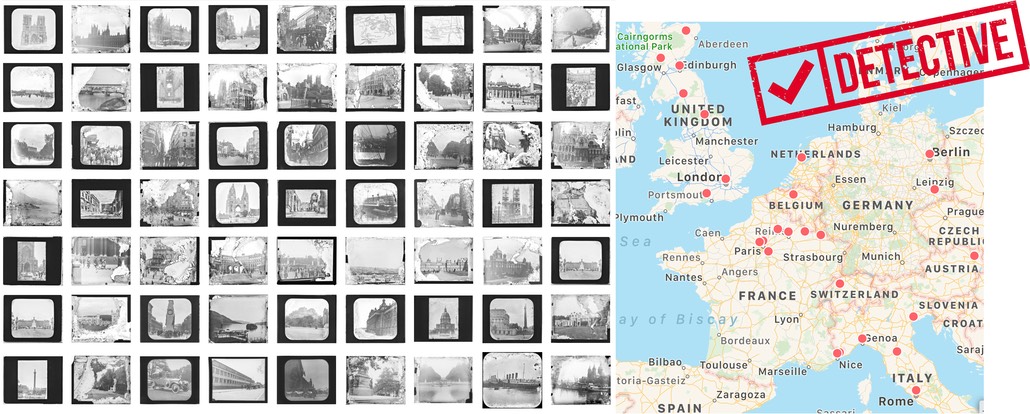
Special Edition Photographic Sleuthing (full image)
In Photographic Sleuthing (Part 2) we introduce a set of images we need help identifying - a community photographic sleuthing excursion as it were.
The Special Edition has been working on a fun photographic project which will result in a handful of early 1900s B&W Magic Lantern glass slides printed in Ziatype (Palladium & Gold) to be displayed in a local Italian cafe.
About two hundred of these inherited slides were sent over for scanning and printmaking. The history of the slides and where they came from is simple: The slides are photographs made by the American couple Mr. & Mrs. True during their post-WWI European tour. The slides themselves are unidentified, deteriorating, and make for most interesting prints.
The problem at hand is the When, Where, What, and Who of each photograph. An intriguing problem and good practice of investigative, deductive, and sleuthing skills. The massive destruction during WWII resulted in significant changes to the cityscapes, making identification based on modern photographs that much more difficult.
Of the slides, we have 60 images identified, 66 not yet located, and the remaining unlikely to be found due to significant physical image degradation or lack of image reference.
From the identified images we have learned the following of Mr. & Mrs. True’s European Tour:
- Tour deduced to take place around 1922
- Trip started in NY at the Chelsea Piers
- Ingress / Egress from Europe was the Southampton Piers
- Atlantic crossing on either White Star or Cunard lines
- Countries traveled: England, Scotland, France, Belgium, Netherlands, Germany, Austria, Switzerland, Italy
- Images are all fair weather, indicating Spring through Fall travel
The following are a few examples of identified photographs and how they were located. For each slide, we try to answer the following questions about their pedigree:
- Orientation (L/R) of image?
- Where was it taken?
- What was location of the camera?
- What year and season was the image created?
- Any identifiable personages?
Aldgate East Station, London, England (full image)
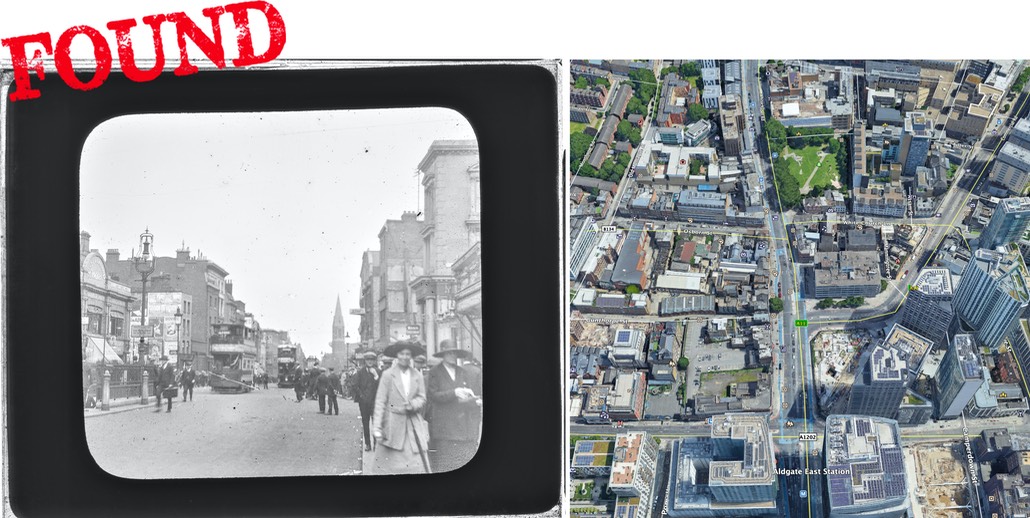
- No indication of when this photo was made
- Visible wording provides correctness of L/R orientation
- Double decker busses on English side of the road infers UK
- We can infer a train station / underground on left based on place names on the building front
- Internet search finds list of London underground stations
- One station in the list matches the partially readable ‘…ATE EAST…TION’ as ’ALDGATE EAST STATION’
- Internet search for Aldgate East Station images reveal a matching (historic) cityscape, including the WWII destroyed St. Mary Matfelon (aka St Mary's, Whitechapel) church in the background of the photograph
Cathedral of Saint Stephen of Metz, Lorraine, France (full image)
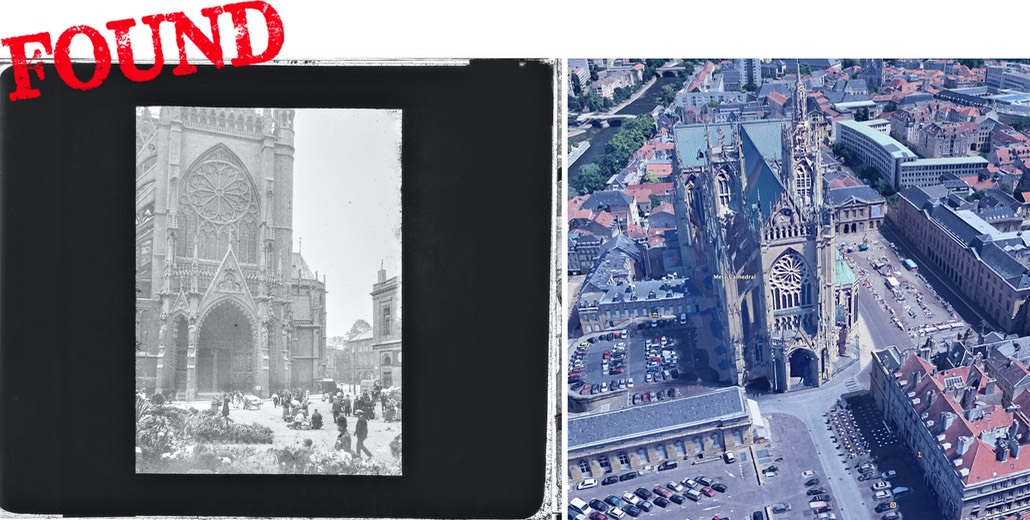
Special Edition Photographic Sleuthing
- No indication of when this photo was made
- This cathedral has a single flying buttress on the left or right
- No obvious indication of L/R orientation
- No visible wording
- No display of how men’s (L over R) or women’s (R over L) shirts are buttoned or fashioned
- No display of of vehicles
- No display of men using a cane in their etiquette (R) hand
- No display of safety officer’s uniforms which could give away image orientation
- No display of statues holding swords in their right hand
- One statue on cathedral is holding a scroll
- How does one hold and read a scroll?
- Internet image search indicates a scroll is held primarily upward with right hand
- With image oriented per scroll holding statue, the single flying buttress belongs on the left side of the cathedral
- Internet image search of cathedrals with a single flying buttress on the left reveals this is the Cathedral of Saint Stephen of Metz
Highcliffe Castle along the Dorset Coast, Highcliffe, Dorset, England (full image)
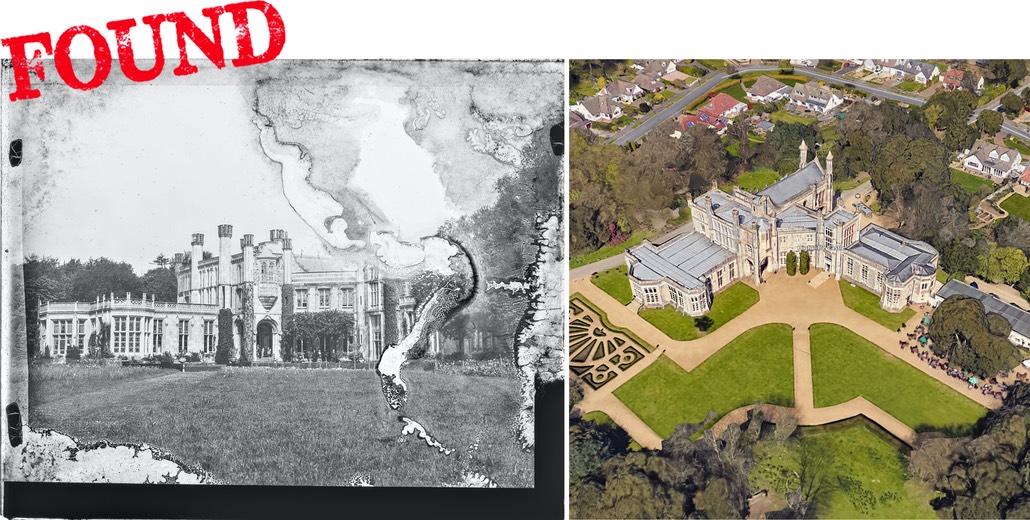
- No indication of when this photo was made
- No obvious indication of L/R orientation
- No obvious indication of location
- Closer examination reveals words inscribed on building facia indicating L/R orientation of image
- A few letters of the inscription are legible with some creative brain twisting
- Words are clearly in Latin
- Lettering rappers to read:
- Top: …AVE MARI MA…
- Bottom: ‘E TERRA MAGNUM…
- Internet search of this Latin phrase leads to a match:
- Suave, mari magno turbantibus aequora ventis
- e terra magnum alterius spectare laborem
- Translation: ’It is pleasant, when the winds are buffeting the waves on the great sea, to watch from the land the great struggle of another'
- This Latin quote indicates this is likely seaside location
- Internet image search for the phrase 'Suave, mari magno turbantibus…etc.’ reveals a travelog showing the castle in question: Highcliffe Castle, Dorset Coast
John Lewis & Co., Oxford Street, London, England (full image)
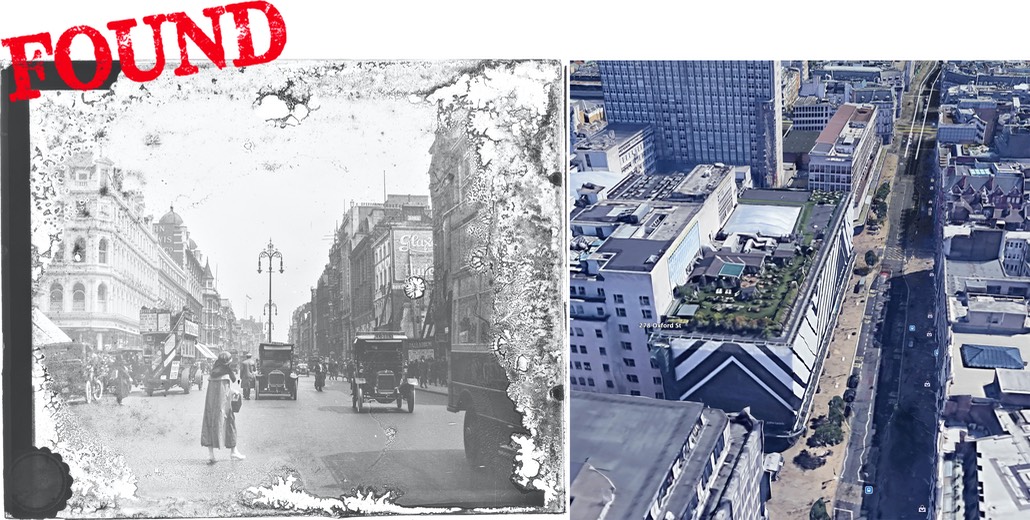
- No indication of when this photo was made
- Wording indicates L/R orientation
- Driving direction indicates UK
- No street signs or other obvious indicators of location
- ‘PALLADIUM’ sign on right hand is unremarkable given an internet search
- ‘Glaxo Super Milk’ is an advertising display with no clear locale inferred
- ‘Wright’s Soap’ is likewise nondescript as to location
- The letters ‘…HN …WIS …Co.’ are intriguing with the creative assumption of ‘John Lewis & Co.’ as the full wording
- Internet search reveals this is the John Lewis & Co. building at 278 Oxford Street, London
- Further internet search shows the street blocks in the foreground and background fencing in the John Lewis & Co. building are Cavendish (foreground) & Holles (background) intersecting Oxford Street
Nice - Promenade des Anglais (full image)

- No indication of when this photo was made
- No obvious L/R orientation
- No obvious wording
- No vehicles
- No clothing to assume men’s vs. women’s attire fixturing
- We do have a person walking, suggesting a L/R orientation. Etiquette suggests the right arm would remain extended to swing or hold a cane and the left hand would be stationary or used when walking a partner.
- Based on the palm trees we can assume an equatorial facing geography
- Based on the shadows of the benches and the person walking, the Sun’s location would assume a Southern-ish facing location of the image with the Sun to the South
- Upon closer examination of the scanned slide, we do in fact have letters – around the corner precipice of the distant building. With some squinting and imagination, the letters read ’negresco’. This also confirms the L/R orientation.
- Internet search for ‘negresco’ reveals the Hotel Negresco, Nice, France.
- Internet search for the historic strand in Nice reveals the location: Promenade des Anglais, Nice, France
Monaco Harbor, Monaco, France (full image)
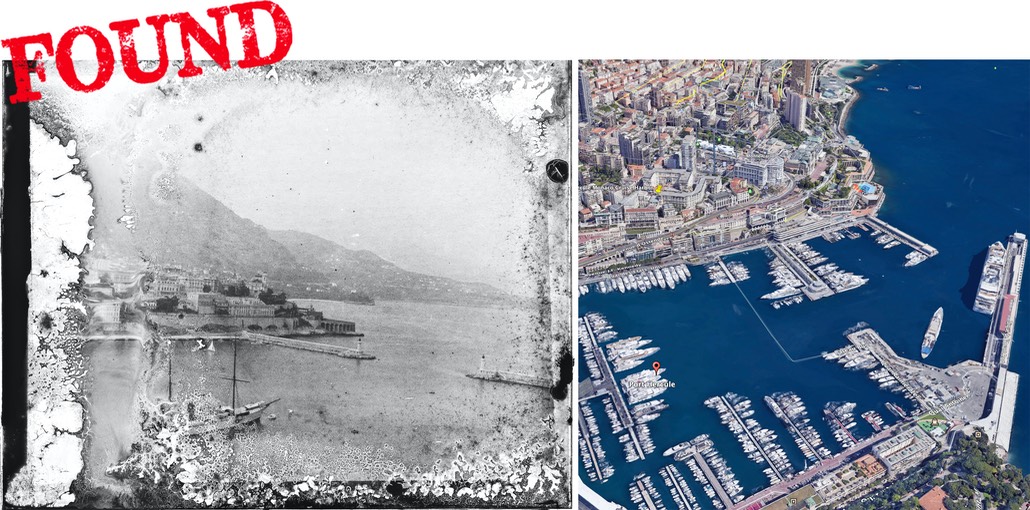
- No indication of when this photo was made
- No obvious indication of L/R orientation
- As we had previously discovered an image of the Promenade des Anglais in Nice, France, we assume this image is along the broader Southern European coastline.
- Using Google Earth to view our way up and down this coastline, we identify major cities that this harbor could indicate, specifically Cannes and Monaco
- Internet searches for historic harbors of both Cannes and Monaco reveal this is the old Monaco harbor
- Given this is the Old Monaco Harbor, we have both location of camera for the photograph as well as L/R orientation
Salle Garnier, the Opéra de Monte-Carlo, Monaco, France (full image)
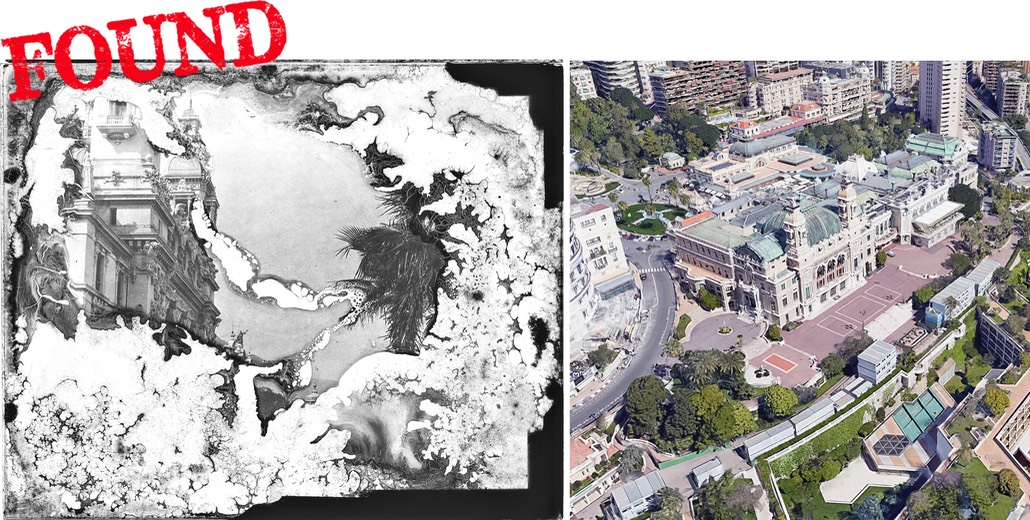
- No indication of when this photo was made
- Absolutely no indication of L/R orientation
- Given the palm trees in this very partial image, we again are going to assume the Southern European coastline, someplace between Genoa and Nice.
- The building is up above the waterline, perhaps on a promontory given the two layers of palm trees visible.
- The sea themed ornamentation on the building reveals this is a coastal location, again signaling a coastline
- Given the cities already discovered, Genoa, Monaco, Nice, it made sense to start looking at the coastal hotels in those cities.
- Given the ornateness of the facade, the primary focus is with Monaco. Bingo - the partial photograph shows a portion of the oceanside facade of the Salle Garnier (Opera Garnier), Monte-Carlo
- We now also have L/R orientation
- Confirmed location by the distant ornate building facing seaside in the Monaco Harbor photograph with the Salle Garnier above the waterline on the promontory
Rome, Italy, imaged from the Faro del Gianicolo monument (full image)
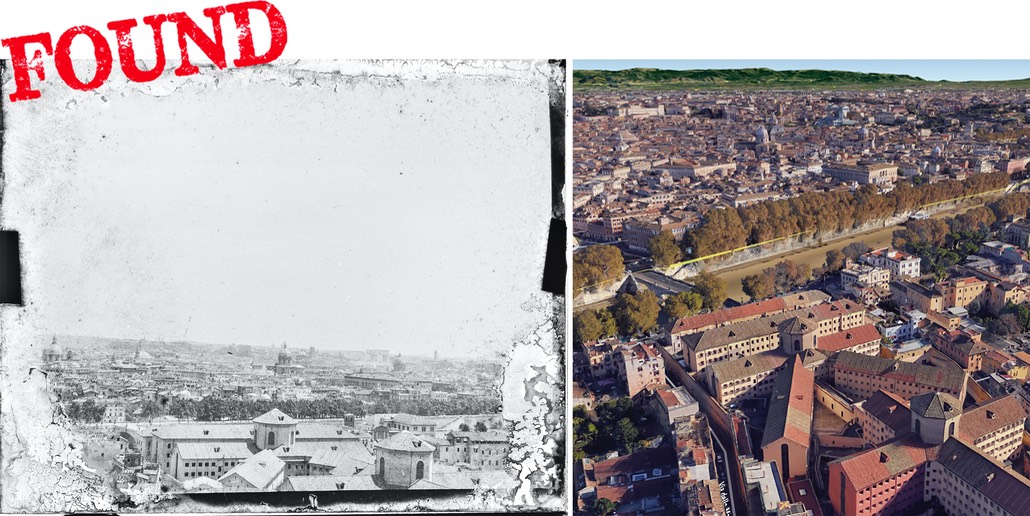
- No indication of when this photo was made
- No indication of orientation
- Photo was taken from on high toward the the city
- Given the structures, we assume Italy, Rome in particular
- Scouting around Rome with Google Earth reveals the Altare della Patria in the distance on one side, with the Pantheon on the other side
- Revolving around this pairing with Google Earth reveals the odd angled building in the foreground as the prison Casa Circondariale di Regina Coeli
- Given this L/R orientation we see the Pantheon on the left, the Altare della Patria on the right, with the Basilica Sant'Andrea della Valle in the middle and the church San Carlo ai Catinari on the far right.
- Given this orientation and view, we can surmise the photographer made this image from the Faro del Gianicolo monument above the prison looking toward the city.
Via Fieschi, Genoa, Italy, toward Basilica di Santa Maria Assunta (full image)
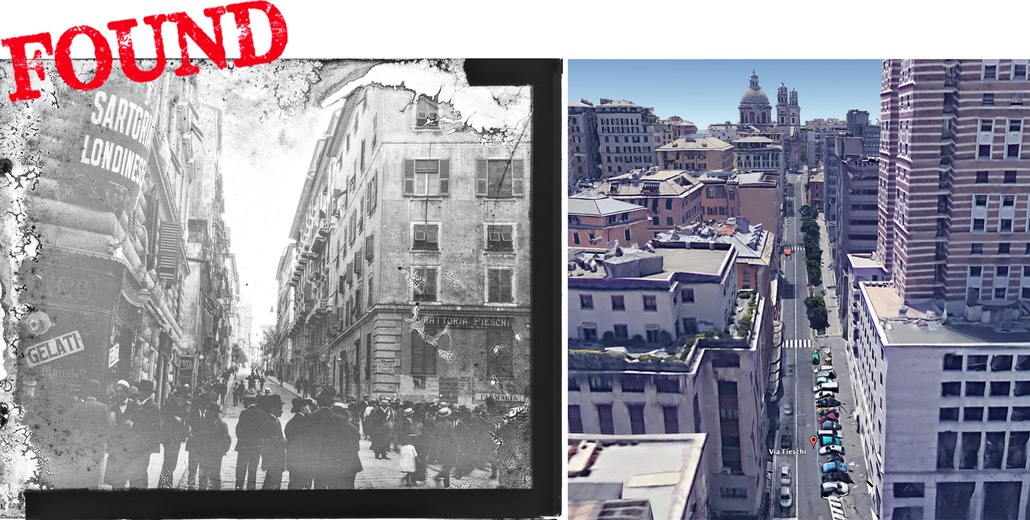
- No indication of when this photo was made
- Wording indicates L/R orientation
- Language indicates this is Italy
- No street names to give away the location
- The basilica in the distance is a landmark, albeit unidentified
- Internet search for the restaurant in the foreground ‘Trattoria Fieschi’ did not turn up helpful information.
- Searching the family name ‘Fieschi’ in Italy turned up the Fieschi family, a noble merchant family of Genoa, Italy.
- As this Italian family must have deserved a street name, looking for Via Fieschi in Genoa resulted in a match with the Basilica di Santa Maria Assunta at the end of the street matching the basilica in the background of the photograph
